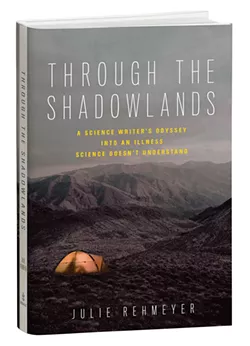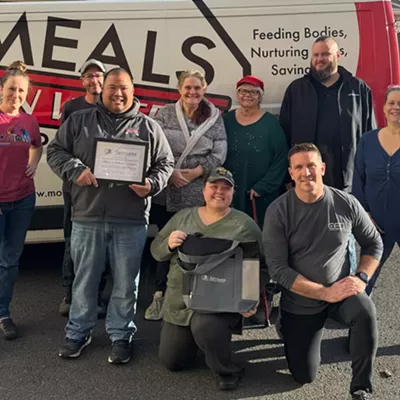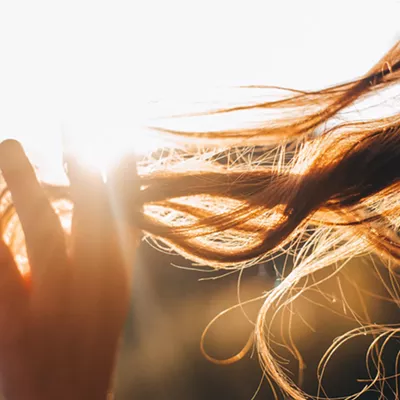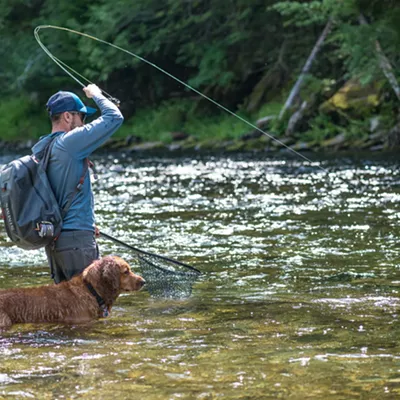Five years ago, against practically anyone's better judgment, I knowingly abandoned any semblance of medical evidence to follow the bizarre-sounding health advice of strangers on the internet. The treatment was extreme, expensive, and potentially dangerous.
If that sounds like a terrible idea to you, imagine how it must have felt to a science journalist like me, trained to value evidence above all. A decade ago, I never would have believed I'd do such a lunatic thing.
But I was desperately, desperately ill. My chronic fatigue syndrome had gotten so bad that I often couldn't turn over in bed. On days when I felt well enough to shop for groceries, my legs would sometimes begin dragging as I walked down the aisle — within a few steps, I might suddenly be unable to move them at all, as stuck as a mouse in a glue trap. Top specialists had run out of treatments for me, and research on my illness was at a near-standstill. It was a hard thing to internalize, but I finally started to accept that science wasn't going to help me anytime soon.
So I took a deep dive into the murky world of untested treatments. The incredible thing is, I found something that brought astonishing improvements, even if not quite a cure. I describe the entire journey in my new memoir, Through the Shadowlands: A Science Writer's Odyssey Into an Illness Science Doesn't Understand. What helped me is no cure-all. But my experience taught me lessons about how to navigate the online world of data-less anecdotes, a place I still recognize as being full of potential scams, pitfalls and harm. But it's also a community that gave me my life back, and if it helped me, it could help other people — provided they take the proper precautions.
MEETING THE MOLDIES
My journey into the online health underworld started just after I wrote a story about chronic fatigue syndrome, also sometimes known as myalgic encephalomyelitis. Writing that story meant "coming out" as having ME/CFS myself, and after it was published, several patients who believed that toxic mold was the source of their ME/CFS started contacting me through Facebook. Although they'd been sicker than me, they said, they had experienced incredible improvements by taking extreme measures to avoid exposure to toxic mold.
Pseudoscientific hogwash, I scoffed. Health authorities confirmed that mold could cause asthma and respiratory problems, but I didn't cough or wheeze; I became semi-paralyzed. Surely, mold couldn't do that.
Still, the patients' stories wriggled like jumping beans in my brain. One of my new Facebook friends posted a link to a previously housebound young man's blog post seemingly validating the theory, complete with pictures of him running through the wilderness after spending two months living in a cargo trailer in the (relatively) mold-free desert. Running! Longing surged through my bloodstream like adrenaline.
I figured just asking a few questions couldn't hurt, so I wrote to the "moldies," as they called themselves. I'd never lived in an obviously moldy house, and moving had never seemed to affect my illness. So mold wasn't my problem, right?
Not so fast, the moldies argued. You can't always see mold in a water-damaged building, they said. And if I'd lived in just one moldy house, my possessions could have picked up enough mold to keep me sick — once you're sensitized, they claimed, tiny amounts of mold can be enough to keep you sick, just as traces of peanut dust can sicken those who are severely allergic.
The moldies proposed an experiment: Spend two weeks in the desert with none of my own (potentially contaminated) belongings to "get clear" of mold. If mold was my problem, they predicted, returning home would make me extremely sick. This intense reaction could help me start detecting the presence of mold, which could in turn help me avoid it — and thus, to heal.
Of course, the moldies could muster no credible scientific evidence for their assertions. Nada. One crusading doctor made big scientific claims, but academic researchers steered clear of the idea. And the moldies' talk sometimes veered into what seemed like sheer paranoia — the word chemtrails popped up once. Still, they were an erudite bunch, including a Harvard-trained lawyer, an MIT computer scientist, an art history professor. And the truth was that when they limited their discussion to mold, their theories sounded as believable to me as any other I'd heard, including from the most pedigreed specialists.
I still thought they were probably deluded. But I also found myself thinking "maybe..." My health was on a bit of an upswing. Perhaps I could pull off a solo trip to the desert. And when it came down to it, I was out of reasonable ideas — only unreasonable ones were left. So a few weeks later, driving a friend's car loaded with new and borrowed gear, I bounced up a rutted track in Death Valley. That mold-free zone would be my home for two weeks.
While there, I didn't feel dramatically better, but I didn't get paralyzed, either. But the real test was yet to come: whether returning home would make me really, really sick. When I got back, I decided to camp outside, saving going inside for the next day. I dashed inside for just a few seconds to grab clippers I needed to cut the wire fence separating me from the spot where I wanted to camp.
That night, I woke up paralyzed, with an intense, unfamiliar sensation I can only describe as "poisoned." I also felt gleeful: Maybe the moldies are right!
SOMEHOW, IT WORKS
Over the next few days, I kept testing the hypothesis. After 15 minutes inside, my body began to crumple. Just handling paper that had been sitting inside crippled me. I was astonished, and I kept worrying I might somehow be deluding myself. (Later, I recruited some friends to help me do an elaborate double-blind, placebo-controlled test, involving a couple of packages of washcloths, to test whether I was imagining things. I almost certainly wasn't — the test showed there was only a 2 percent chance I'd have done as well by guessing.) It was interesting to see that mold might make me worse. But the real question was, could avoiding it make me better?
After another week of scrupulous avoidance, I decided to take a gentle walk. When my body managed to propel me to the top of a 350-foot hill, my breath caught and turned to sobs.
That was just the beginning. Within months, I was running again. My body became a mold-meter: Entering a moldy building, my teeth chattered or my gait stiffened. I'd flee, changing my shirt and rinsing off. These days, as long as I successfully avoid mold (which, at times, is an absurdly demanding task), I feel nearly well. I'm able to travel, hike, dance, work — my life is utterly changed.
My mold-avoidance experience is so far from any conventional scientific expectations that I'm often incredulous that it actually works. I'm used to assessing a treatment by talking with my doctor and reading studies, not by talking with strangers and performing elaborate, unlikely experiments. Being forced to take another path showed me that patient communities can possess wisdom that doctors can rarely match. The problem is, they also possess a level of bullshit doctors rarely match, so the trick is figuring out which is which.
Of course, the fact that patient communities sometimes find answers that scientists and doctors have missed doesn't mean that all of modern medicine is misguided. In fact, it seems inevitable to me that patients will sometimes discover answers science hasn't yet explored. Patient communities, I've come to see, are a bit like guerrilla fighters. They're intimately familiar with the terrain of illness, and they can quickly mobilize to explore a new, radical idea. On the other hand, they don't have the organization or discipline or resources that armies of scientists have. But the scientific armies move slowly, and sometimes never arrive.
Patients and scientists are both fighting the illness, not one another — or at least should be. And those of us who live in both camps can adopt both guerrilla and army tactics in waging the battle. ♦
The Five-Way Test
I've found that leveraging the wisdom of online patient communities boils down to five key principles — all of which are also basic principles of both journalism and science:
1 Above all: Listen, but nurture your inner skeptic. Demanding scientific proof in a realm science has abandoned will go nowhere, so a kind of radical open-mindedness is essential. But because compelling personal stories can be dangerously seductive, especially when pain and emotion are part of the mix, skepticism is equally crucial.
2 Keep a sharp eye out for possible downsides. Is a treatment invasive? Expensive? Potentially dangerous? Will following one course of treatment preclude others? The risks are not always obvious: Dietary supplements, for example, aren't necessarily benign just because they're "natural." The great injustice of following untested treatments is that their side effects are also untested.
3 Evaluate your sources. In the case of recommendations from patients, that means evaluating the patients themselves — which typically requires getting to know them pretty deeply. Some key questions to ask: How thoughtful and trustworthy do the patients seem? How similar is their situation to yours? How critical and precise do they tend to be about their own experiences? How much have they really benefited from the treatment? Do they have objective evidence to back this up? Subjective reports of vague improvements can easily be wrong. Do they present themselves with excessive authority? Do they, for example, use impressive-sounding, scientific terms they can't explain? This is a huge red flag.
4 Constantly look for contrary evidence and alternative explanations. Or, to put it another way, stay humble. The more you invest in a solution, both physically and emotionally, the more likely you are to want it to work. That desire makes it easy to come up with ever-more elaborate theories to explain away contrary evidence. This is the best way to delude yourself. If you're not naturally skeptical, make yourself explain your ideas to a friend and have her give you an honest reaction.
5 Don't imagine you know more than you do. Without research, it's often anyone's guess just how a particular treatment works, but the only thing that matters is whether the treatment works. Eventually, I did extensive research trying to figure out the mechanism by which mold might be sickening me. I found recent studies suggesting three different newly discovered ways it might be happening, but I still don't know how it works. My improvement was so overwhelming, however, that I figured even if this is the placebo effect, it's good enough for me.
Julie Rehmeyer is author of Through the Shadowlands. She lives in Santa Fe and has written for the New York Times, O,Wired and Slate.com, where a version of this story first appeared.

















